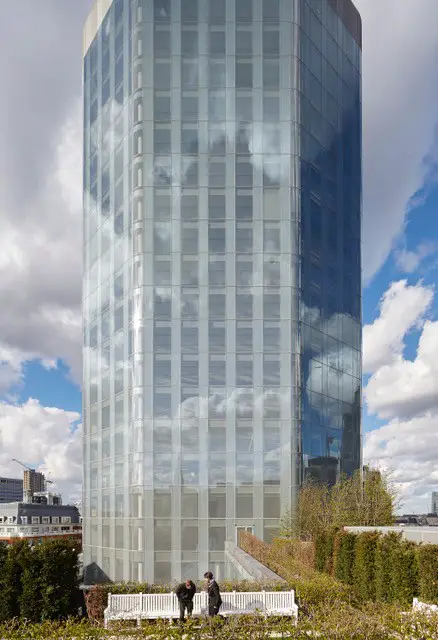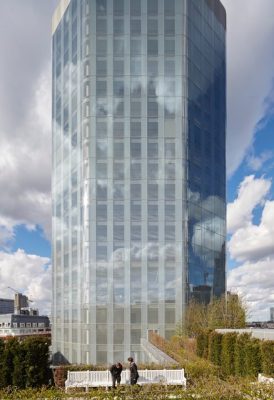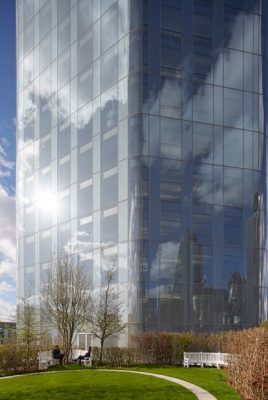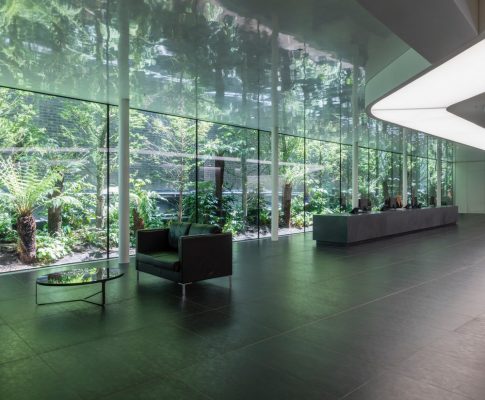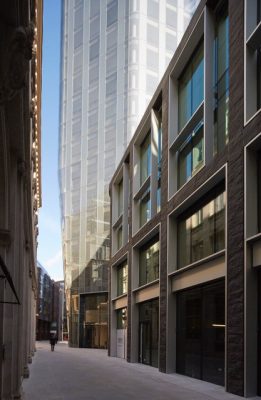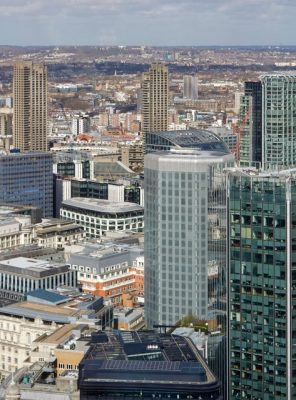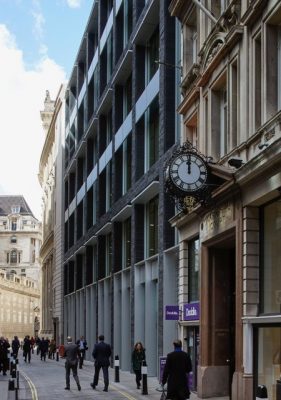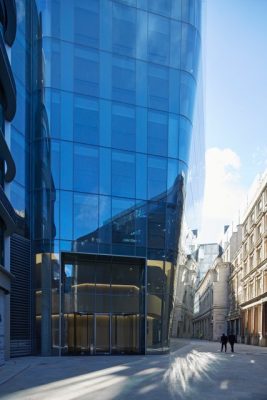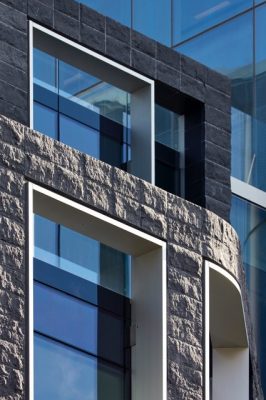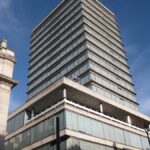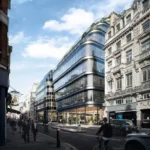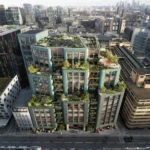Angel Court London, City Tower Building, Real Estate Project News, Architecture Images
Angel Court, City of London Tower
Unobtrusive Building Development in UK Capital for Mitsui Fudosan / Stanhope – design by Fletcher Priest Architects
27 May 2017
Angel Court, City of London Tower Development
Design: Fletcher Priest Architects
Location: London EC2N, UK
How to build an ‘unobtrusive’ tower in the city of London, covered in gardens
Angel Court, City of London Tower
For: Mitsui Fudosan / Stanhope
Fletcher Priest has completed Angel Court for Mitsui Fudosan UK and development partner Stanhope. The last tower of the ‘first generation’ of tall buildings in the Bank of England Conservation Area, Angel Court is located at the heart of the City’s financial district.
Fletcher Priest carried out extensive studies for client Mitsui Fudosan / Stanhope that examined new-build, re-build and refurbishment options for the 1970s structure before deciding to replace all but the core and foundations of this 25-storey building.
An ambition to create as sustainable a city building as possible has surpassed expectations by trebling the tower’s energy efficiency; Angel Court has achieved 2014 BREEAM Excellent (despite having been designed for 2011 standards) and an EPC A rating, far exceeding its original targets. Project Architect Ed Williams says: “Achieving this degree of sustainability for a commercial building is virtually unprecedented. Coupled with that, we’ve made significant improvements to the public realm and created substantial external space for the offices in the form of terraces and gardens. I’m proud to say that this really is a very unusual city building.” The building has just been shortlisted for Worshipful Company of Architect’s City Building of the Year 2017.
The new tower hovers above Angel Court, formerly a cut-through from Lothbury to Copthall Avenue, now improved to create 40% more public realm. With this additional space comes public seating, newly commissioned public artworks and a space flooded with light at the tower’s base, all of which give Angel Court a distinctive entrance and street presence.
The most noticeable aspect of the tower is its skin, which flows as a softly curved homogenous surface around the walls and roof of the original octagonal form. During the day, glimpsed through the close-knit grain of the City’s streets, its translucency gives it a distinctive, light presence. As daylight fades, interior lighting takes over bringing a transparency to the skin, while the glass covering the gridded frame at the base remains opaque. These effects come from a double frit, a ceramic dot baked onto the glass surface, which allows views from inside to out and offsets solar gain.
Contrasting with the opalescent exterior of the tower’s ‘Sky Floors’ are the Carlow grey-blue limestone blocks of the 6-storey ‘Garden Floors’ at the building’s base. Previously a heavy brown, granite façade, a limestone grid now flows up the building and across its terraces to form the balustrades of gardens on these lower floors. Deep, recessed window openings are lined with natural anodised aluminium frames, creating a white façade at ground level, while brise soleils shade the interior from direct sunlight.
On the Bank side, Fletcher Priest has created a Portland Stone extension to connect and match Angel Court to its neighbouring 41 Lothbury. From there, the split-faced blue limestone conducts the eye up the new building. At street level on the Angel Court side, food and beverage offerings Coya, Natural Kitchen and Notes are all about to open. Fletcher Priest worked with the client and Contemporary Art Society which commissioned two artworks by Sara Barker that link either end of the site, from the North entrance to Throgmorton Passage, both containing references to the history of the neighbouring Threadneedle Street.
There was sufficient capacity within the existing tower and podium structure for modifications to realise the most efficient and cost-effective layout. In effect, the five new garden floors are added to the tower without increasing height by relocating existing service floors and enlarging floor plates to give larger, day-lit and more usable core to-perimeter workspaces, with floor to ceiling heights of 2.9m. Reusing the tower and below-ground structure alone retains 75% of the existing concrete on the site and avoids 1,750 truck journeys that would have been needed to transport demolition waste.
Banks of escalators lead from the spacious ground floor lobby, which is hung with monumental scale artworks by Simon Callery, to the first floor reception. Here a generous central lobby is enlivened by a woodland diorama behind the reception desk. Reflective materials, roof lights and concealed lighting improve the sense of light and space inside the building, enhanced by continual views over the canopy of foliage on the lower Garden Floors and out to the roof terraces and dramatic 360 views of the Sky Floors. All occupants can access the 7th floor garden terrace that is part of the building’s 10,000ft2 (930m2) of private, landscaped, open space, spread over five levels. Fletcher Priest collaborated with Vogt Landscape Architects to bring a special quality to this principal garden, with tall hedging and trees around the lawns creating the sense of a series of protected, walled garden rooms.
Office floors have been designed to provide workspace for anywhere from 80 to 300 people. All floorplates throughout the building have been replaced to maximise the ingress of daylight. Deeper spaces at lower levels benefit from 2.9m floor-to-ceiling heights, whilst shallower sky floors appear bright due to uninterrupted light and generous 2.7m clear heights. The floorplates are characterised by floor to ceiling glass, which draws views of the terraces and garden spaces into the building and gives vistas over the dramatic skyline beyond.
Daylight responsive light fittings, all with energy conserving LEDs, automatically adjust their brightness depending on occupancy, movement and available natural light. Services on the sky floors are neatly hidden in black grooved soffits that ‘disappear’ into the fabric of the building by working with the geometry of the tower. This geometry has also dictated the arrangement of WC facilities, with simple, clean lines that rationalise sometimes awkward spaces. The effect here is of luxury, yet the materials are largely recycled: backlit splashbacks made from recycled glass have a natural, intricate pattern that offsets the minimal walls and cubicle doors. The latter are clad in 70% recycled paper mixed with resin.
Gwyn Richards, Assistant Director (Development Design) at City of London says: “Fletcher Priest’s design for the tower is sleek and graceful with the translucency of the fritted glazing resulting in a light, gentle and refined presence on the City’s skyline with a warm and approachable quality. It’s a beautifully crafted and executed tower fully deserving of its place alongside the other City towers.
The contrast between the masonry framed street blocks sitting comfortably within the City’s historical masonry streets and the elegant lightweight quality of the tower is convincing. Utilizing the roofs of the building as roof terraces is very welcomed, and characteristic of Fletcher Priest practice’s approach which reflects the City’s own aspirations to exploit the use of the City’s roofs for access, especially wider public access. The scheme delivers a significant increase in high quality public realm with active retail frontages enlivening a key route within the City and providing a place to dwell of significant wider public benefit. It’s a scheme the City can be proud of.”
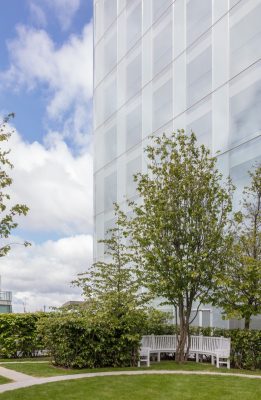
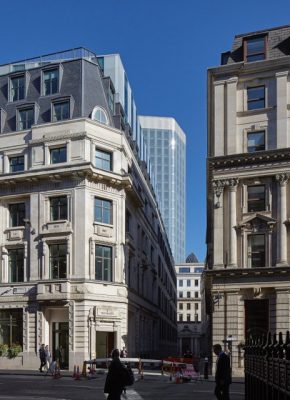
photo – left © Nicholas Worley ; photo – right © Edmund Sumner
About Fletcher Priest Architects
Fletcher Priest is a cosmopolitan, award-winning practice with around 100 people working on significant urban design, architectural, interior, graphic design and research projects. The practice has developed a reputation for finding elegant solutions to complex design problems. With expertise in workplace design, Fletcher Priest was named BD Office Architect of the Year in 2017, and has built headquarters for some of the world’s leading organisations such as Sony, Vodafone and Nomura.
Sustainability
Angel Court was one of the first commercial buildings in the UK to achieve a 2014 BREEAM Excellent rating. The projected environmental performance goes beyond required standards, providing anticipated energy savings in excess of £12 million over 20 years. The EPC rating is A, which is unprecedented for this category of building.
40% of the existing structure (essentially the core) was retained, dramatically reducing building outlay. Other sustainability credits include:
• The double frit on the exterior, which limits solar gain
• All lighting in the building is LED
• Rainwater harvesting
• Fletcher Priest discovered that the Carlow Blue limestone, which originates in Belgium, is contained in a seam that passes beneath the Channel and re-emerges in Ireland. They therefore sourced the stone from Ireland, significantly reducing travel distance.
Angel Court, City of London Tower images / information received May 2017
Location: Angel Court, London, England, UK
London Building Designs
Contemporary London Architecture Designs
London Architecture Designs – chronological list
London Architecture Walking Tours – tailored UK capital city walks by e-architect
City of London Skyscrapers
Key Towers in the Square Mile
1 Leadenhall Tower
Design: Make Architects
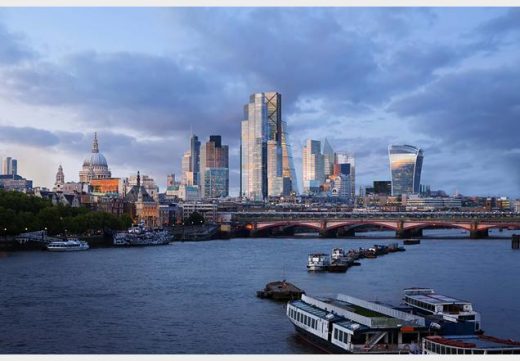
image courtesy of architects
1 Leadenhall Tower Building – planning approval news update + 1 Leadenhall London Tower
22 Bishopsgate
Design: PLP Architecture
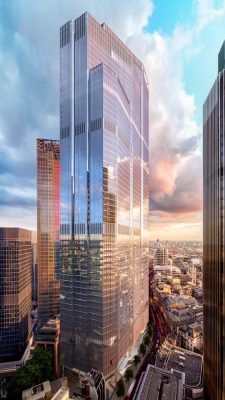
image : Riverfilm Martin Richardson
The 22 Bishopsgate tower
Comments / photos for Angel Court, City of London Tower – Architecture page welcome
Website: Angel Court

